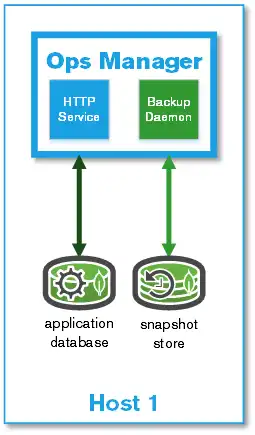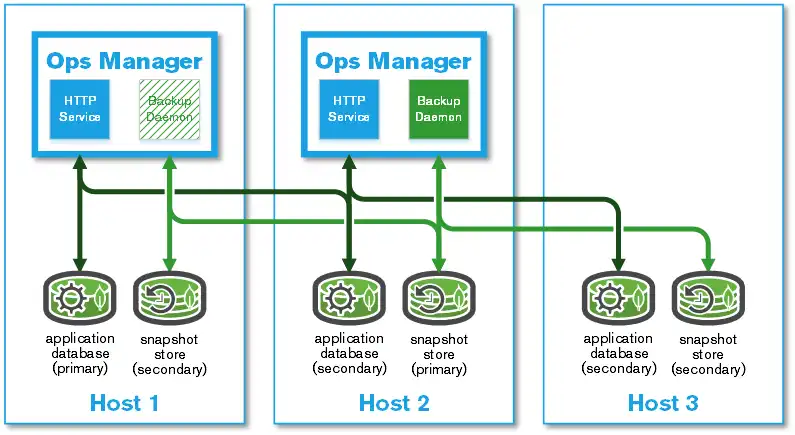Example Deployment Architectures
The following examples illustrate some possible MongoDB and Ops Manager deployments.
Considerations
On FCV 4.0 and earlier, for best performance on any of these installs, configure each backup host with two disk partitions: one for the snapshot store or File System Store and one for the head databases.
On FCV 4.2 and later, backups no longer require
head databases. For more information, see
Backup Daemon Service.
Test Install on a Single Host
For a test deployment, you can deploy all of the Ops Manager components to a single host, as described in Install a Simple Test Ops Manager Installation.

Note
If you would like to test backup services, use the Ops Manager Application to configure them. When configuring Ops Manager, you can specify the backup settings.
For FCV 4.0 and earlier, the Backup Daemon service creates the head databases dynamically in that directory. The Backup Daemon service then manages these head databases.
For FCV 4.2 and later, the application database stores
snapshots of deployment state in
backup cursors.
Production Installs
Redundant Metadata and Snapshots
This deployment provides redundancy for the Ops Manager Application Database and Snapshot Storage in the event of host failure. The deployment runs the database in a MongoDB replica set with three data-bearing members with copies of the data.
Important
This deployment provides high availability for the Ops Manager Application.
Ops Manager uses a w:2
write concern, and can
tolerate the loss of one data-bearing node from the
Ops Manager Application Database. To make the deployment more
durable, enable journaling.

Note
All hosts must satisfy the combined hardware and software requirements for both the systems specified in the System Requirements column.
Host | System Requirements | Purpose |
|---|---|---|
1 |
| Serves the Ops Manager Application database primary and the snapshot store secondary. |
2 |
| Serves the snapshot store primary and the Ops Manager Application database secondary. |
3 |
| Hosts the Ops Manager Application Database and snapshot store secondary replica set members. Replica sets provide data redundancy and are strongly recommended, but are not required for Ops Manager. |
For an example tutorial on installing the minimally viable Ops Manager installation, see Install a Simple Test Deployment on RHEL.
Highly Available Ops Manager Application and Multiple snapshot stores
This Ops Manager deployment runs multiple instances behind a load balancer to provide high availability for Ops Manager. This deployment scales out to add an additional snapshot store.

The deployment includes:
two hosts that serve the Ops Manager Application and the Ops Manager Application Database
four hosts that serve Ops Manager Application with Backup enabled and Backup Databases
additional hosts to serve the remaining members of each replica set
Deploy an HTTP Load Balancer to balance the HTTP traffic for the Ops Manager Application. Ops Manager does not supply an HTTP Load Balancer. You must provision, deploy, and configure it yourself. A load balancer placed before of the Ops Manager Application hosts must not return cached content.
All of the software services need to be able to communicate with the Ops Manager Application Databases and the snapshot stores. Configure your firewalls to allow traffic between these hosts on the appropriate ports.
Note
All hosts must satisfy the combined hardware and software requirements for both the systems specified in the System Requirements column.
Host | System Requirements | Purpose |
|---|---|---|
1 & 2 |
| Serves the primary and secondary for the Ops Manager Application database. |
3, 4, 5 & 6 |
| Serves the primary and secondary for the two snapshot stores. Only the Backup Daemon needs to communicate with the head
databases. As such, their |
7 & 8 |
| Serve the remaining replica set members for the Ops Manager Application Database and the two snapshot stores. |
To learn how to install Ops Manager with high availability, see Configure a Highly Available Ops Manager Application.